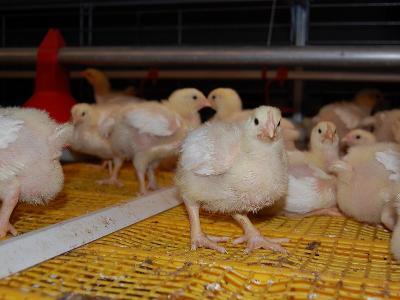Should US, EU growers ignore cage housing for broilers?

One European agricultural school is studying broiler production where the chickens are housed in a modern, tiered above-the-floor-housing-system, or what might commonly be called cages. | Terrence O'Keefe
With many laying hens coming out of cages, most poultry producers in the U.S. and EU won’t even consider raising broiler in cages, but should they?
I wanted to take the opportunity provided by my attendance at EuroTier to visit some cage-free layer operations on my trip to Europe. Almost by accident, the opportunity to visit a demonstration unit at an agricultural school gave me my first in-person look at an occupied modern, tiered above-the-floor-housing-system, or what might commonly be called cages, for broilers. The residents of this system were 13 days old and will be marketed at 35 days of age.
These birds are raised without use of drugs and they have markedly better feed conversion and growth rates than floor-raised birds do. I was told that integrators in Asia that raise broilers in both cage systems and on the floor achieve dramatically better performance than the cage-housed birds. They routinely have a feed conversion that’s 20 points better and reach a market weight of 2.0 kilograms (4.4 pounds) in five fewer days.
Separating the broilers from their droppings improves bird health, feed conversion, in-house air quality, and it eliminates the need for bedding. A well designed cage housing system can also have automated bird unloading into transport crates integrated into the system.
Laying hens are coming out of cages in the EU and the U.S. partly because hens can stay in lay for over a year and a well-managed cage-free flock can come fairly close to the performance of a cage-housed flock. The real cost for cage-free layers is the increased housing cost per bird, not because of reduced bird performance.
It appears that broilers raised on the floor are markedly less efficient than are cage-produced birds and it requires a lot more square footage of building which offsets the cost of the cage.

Raising broilers in cages make drug-free growing programs easier to implement. Will consumers accept a few weeks in cages for broilers to get no-antibiotics-ever chicken? | Terrence O'Keefe
Will consumers accept cage use for broilers?
The current thinking is that consumers won’t accept cage use for raising broilers, but if the bird is only in the cage for five weeks, will consumers care? If five weeks is too long, what about some future date where birds are marketed at 28 days of age? Or what about systems that would house the birds in cages for the first two or three weeks and then the birds are put on the floor to raise them to heavy weights?
I couldn’t find anything to object to in the demonstration system that I visited. Can the broiler industry afford to turn its back on technology that yields healthier, more productive birds with less drug use?
Terrence O'Keefe is editor of Egg Industry and content director of agri-business at WATT Global Media.
Terrence O’Keefe, WATT’s content director of agri-business, provides his perspective on developments affecting processing and food safety related issues in the poultry, egg and swine industries. Terrence has covered the poultry industry as an editor for over a decade and also brings his experience in plant management and live production to bear on today’s issues.
Có thể bạn quan tâm
Phần mềm

Phối trộn thức ăn chăn nuôi

Pha dung dịch thủy canh

Định mức cho tôm ăn

Phối trộn phân bón NPK

Xác định tỷ lệ tôm sống

Chuyển đổi đơn vị phân bón

Xác định công suất sục khí

Chuyển đổi đơn vị tôm

Tính diện tích nhà kính

Tính thể tích ao hồ



 Slow-growing broilers provide welfare goals for growers
Slow-growing broilers provide welfare goals for growers  Consumer demand is best illustrated by providing choices
Consumer demand is best illustrated by providing choices